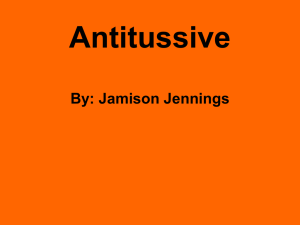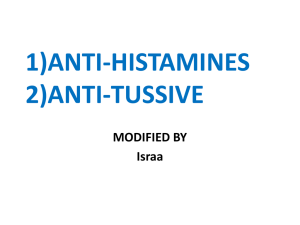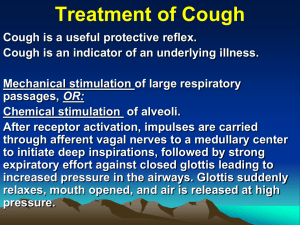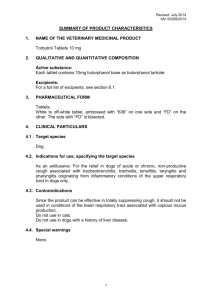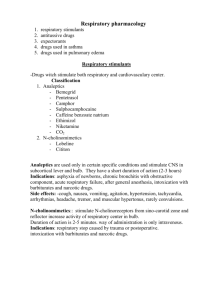Document 13308336
advertisement
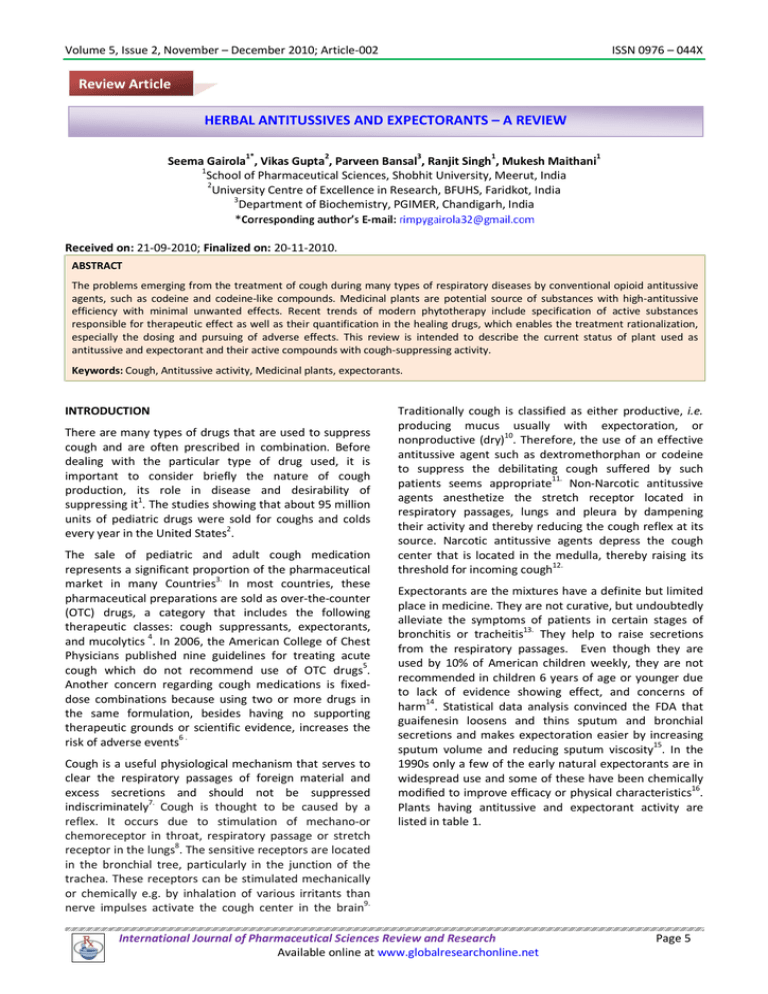
Volume 5, Issue 2, November – December 2010; Article-002 ISSN 0976 – 044X Review Article HERBAL ANTITUSSIVES AND EXPECTORANTS – A REVIEW 1* 2 3 1 1 Seema Gairola , Vikas Gupta , Parveen Bansal , Ranjit Singh , Mukesh Maithani 1 School of Pharmaceutical Sciences, Shobhit University, Meerut, India 2 University Centre of Excellence in Research, BFUHS, Faridkot, India 3 Department of Biochemistry, PGIMER, Chandigarh, India Received on: 21-09-2010; Finalized on: 20-11-2010. ABSTRACT The problems emerging from the treatment of cough during many types of respiratory diseases by conventional opioid antitussive agents, such as codeine and codeine-like compounds. Medicinal plants are potential source of substances with high-antitussive efficiency with minimal unwanted effects. Recent trends of modern phytotherapy include specification of active substances responsible for therapeutic effect as well as their quantification in the healing drugs, which enables the treatment rationalization, especially the dosing and pursuing of adverse effects. This review is intended to describe the current status of plant used as antitussive and expectorant and their active compounds with cough-suppressing activity. Keywords: Cough, Antitussive activity, Medicinal plants, expectorants. INTRODUCTION There are many types of drugs that are used to suppress cough and are often prescribed in combination. Before dealing with the particular type of drug used, it is important to consider briefly the nature of cough production, its role in disease and desirability of suppressing it1. The studies showing that about 95 million units of pediatric drugs were sold for coughs and colds every year in the United States2. The sale of pediatric and adult cough medication represents a significant proportion of the pharmaceutical market in many Countries3. In most countries, these pharmaceutical preparations are sold as over-the-counter (OTC) drugs, a category that includes the following therapeutic classes: cough suppressants, expectorants, and mucolytics 4. In 2006, the American College of Chest Physicians published nine guidelines for treating acute cough which do not recommend use of OTC drugs5. Another concern regarding cough medications is fixeddose combinations because using two or more drugs in the same formulation, besides having no supporting therapeutic grounds or scientific evidence, increases the risk of adverse events6 . Cough is a useful physiological mechanism that serves to clear the respiratory passages of foreign material and excess secretions and should not be suppressed 7. indiscriminately Cough is thought to be caused by a reflex. It occurs due to stimulation of mechano-or chemoreceptor in throat, respiratory passage or stretch 8 receptor in the lungs . The sensitive receptors are located in the bronchial tree, particularly in the junction of the trachea. These receptors can be stimulated mechanically or chemically e.g. by inhalation of various irritants than nerve impulses activate the cough center in the brain9. Traditionally cough is classified as either productive, i.e. producing mucus usually with expectoration, or nonproductive (dry)10. Therefore, the use of an effective antitussive agent such as dextromethorphan or codeine to suppress the debilitating cough suffered by such patients seems appropriate11. Non-Narcotic antitussive agents anesthetize the stretch receptor located in respiratory passages, lungs and pleura by dampening their activity and thereby reducing the cough reflex at its source. Narcotic antitussive agents depress the cough center that is located in the medulla, thereby raising its threshold for incoming cough12. Expectorants are the mixtures have a definite but limited place in medicine. They are not curative, but undoubtedly alleviate the symptoms of patients in certain stages of bronchitis or tracheitis13. They help to raise secretions from the respiratory passages. Even though they are used by 10% of American children weekly, they are not recommended in children 6 years of age or younger due to lack of evidence showing effect, and concerns of harm14. Statistical data analysis convinced the FDA that guaifenesin loosens and thins sputum and bronchial secretions and makes expectoration easier by increasing sputum volume and reducing sputum viscosity15. In the 1990s only a few of the early natural expectorants are in widespread use and some of these have been chemically 16 modified to improve efficacy or physical characteristics . Plants having antitussive and expectorant activity are listed in table 1. International Journal of Pharmaceutical Sciences Review and Research Available online at www.globalresearchonline.net Page 5 Volume 5, Issue 2, November – December 2010; Article-002 ISSN 0976 – 044X Table 1: Plants having Antitussives and Expectorant activity S. No. 1 2 3 4 5 6 7 8 9 10 11 12 13 14 15 16 17 18 19 20 21 22 23 24 25 26 27 28 29 30 31 Botanical Name (Common Name) Abies webbiana Lindl. (Indian Silver Fir) Abrus precatorius L. ( Indian liquorice) Acacia concinna wild. DC (Shikakai) Acorus calamus L. ( Sweet flag) Adhatoda vasica L.Nees (Vasaka) Agaricus albus Linn (Purging agaric) Ailanthus excelsa Roxb. ( Tree of heaven) Alhagi pseudalhai Bieb. Desv (Camel thorn) Allium odorum L. ( Sweet leek) Allium porrum Linn (Leek) Althae officinalis Linn (Marshmallow) Amomum aromaticm Roxb. (Bengal cardamom) Anagallis arvensis Linn. (Chari saben) Andrographis paniculata Burm.f. Nees (Kalmegh) Artemisia Vulgaris Linn. (Arbaaka) Asparagus racemosus Wild (Shatavari) Azima tetracantha Lam. (Mistletoe) Bacopa monnieri L. (Brahmi) Balanites aegyptiaca Linn.Delile. (Deseart date) Balsamodendron Myrrha Nees. (Surasa, Barbara) Belamcana chinensis L. (Leopard lily) Bischofia javanica B. (Vinegar wood) Blepharis linariaefolia Pers. (Naethira Poondu) Blumea Balsamifera L. DC (Kukur Sunga) C. longa Linn(Turmeric) Caesalpina Bonducella F. (Kuberakshi) Cassia Tora L. (Cakunda) Celosia Cristata Linn. (Cock’s comb) Cephaelis ipecacuanha Rich. (Ipecac) Chelidonium major L. (Tetter wort) Chondrus crispus L. ( Pearl Moss) Pinaceae Part used L Leguminosae R, L, S Mimosaceae L Araceae Rz Acanthaceae Agaricaceae L, R, F, B WP Simaroubaceae B Fabaceae WP Liliaceae L,B Liliaceae L Malvaceae L,R Zingiberacea Family Chemical Constituent Activity Reference Flavonoids, biflavonoid glycosides and phytosterols. (L+) abrin, glucosides (abralin, haemagglutinin), NMethyltryptophan and Urease. Saponin, lupeol, aspinasterol and acacic acid lactone. It also contains hexacosanol and aspinasterone Sesquiterpenes, phenylpropanes, cis-isoasarone, acorone, ketones. vasicine, vasicinone, Maiontone. vasicinolone, vasicol, kaempferol Agaric acid (agaricin) present to the extent of 1416%. Quassinoids including ailanthone derivatives. Antitussive [17] Antitussive [18] Expectorant [19] Antitussive [20] Expectorant [21] Expectorant [22] Expectorant [22] Expectorant [22] Expectorant [18] Expectorant [22] Antitussive [23] Fr Flavonoids, tannins, sterols, triterpene, saponins and anthroquinones Sulfur compounds, saponins And alkaloids. Non-toxic saponins, thiosulphates, flavonoids, quercetin and kaempferol. Starch, mucilage, pectin, flavonoids, phenolic acids, tannins, quercetin, kaempferol. Essential oil from seeds 1-1.5% containing cineole. Antitussive [22] Primulaceae L Saponins, valerian, cyclanins. Expectorant [23] Acanthaceae L Diterpenoid lactones (andrographolides), paniculides, farnesols and flavonoids Expectorant [18,21,24,25] Asteraceae F,R A volatile oil, an acrid resin and tannin. Expectorant [26] Liliacea R, L Antitussive [27] Salvadoraceae L Asparagamine A, quercetin, rutin hyperoside, Mucilages, Alkaloid, azocarpine, carpine. Expectorant [22] Scrophulariaceae R, S, F ,Fr S Alkaloid, brahmine Antitussive [27,28] Diosgenin, steroidal saponins, balanitins Expectorant [18] Burseraceae R, L, Se Polysaccharides, volatile oil, eugenol, monoterpenes Expectorant [18] Iridaceae Rz Belamcandin, tectoridin, shekanin and Iridin. Expectorant [18] Euphorbiaceae L, Sh Tannin, Vit c. Antitussive [18] Acanthaceae L Sesquiterpene lactones. Expectorant [26] Asteraceae. L Antitussive [29] Zingiberaceae Rz Antitussive [30,31] Leguminosae Antitussive [32] Caesalpinaceae Se, R, B, L Se ,L Borneol, caryophyllene, ledol phytol, caryophyllene oxide, guaiol. Curcumin, Essential oil, ketone, alcohol, Zingiberine. Aminoacids, aspartic acid, arginine, phenolic. Antitussive [33,34] Amaranthaceae F, Se Antitussive [26] Rubiaceaea L Expectorant [28] Papaveraceae R Antitussive [35,36] Gigartinaceae Fr Emodin, glucose, chrysophanol , rhein, oleic, linolic, palmitic Betanin, Amarantinin, Isoamarantinin, Celosianin, Protein. Emetine, cholin, cephaeline ipecacuanhic acid, and nauseating ethereal oil. Chelidonine, homochelidonine, berberine, protopine. Polysaccharides, carrageenan, tannins, iodine, bromine, iron, Expectorant [18] Smaroubaceae International Journal of Pharmaceutical Sciences Review and Research Available online at www.globalresearchonline.net Page 6 Volume 5, Issue 2, November – December 2010; Article-002 S. No. 32 33 34 35 36 37 38 39 40 41 42 43 44 45 48 49 50 51 52 53 54 55 Botanical Name (Common Name) Cimicifuga racemosa Nutt. (Black snakeroot) Citrus japonica Thunb. (Marumi Kumquat) Coleus amboinicus Lour. (Indian borage) Cressa cretica Linn (Rudanti) Curcuma Zedoaria Berg. Rosc. (Cochin turmeric) Eclipta alba L. (Bhangra) Eucalyptus globulus Labill (Australian Fever) Euphorbia antiquorum Linn. (Indian spurge) Euphorbia hirata L. (Snakeweed) Euphrasia officinalis Linn. (Eyebright) Foeniculum vulgare Meller (Fennel) Ginkgo biloba L. (Balkuwari) Glycyrrhiza glabra Linn. (Liquorice) Inula helenium L. ( Tu-mu-xing) Kaempferia galanga L. (Black thorn) Lindera benzoin L. Blume (Spicewood) Lobelia inflate Linn. (Indian Tobacco) Ocimum sanctum Linn. (Tulsi) Papaver rhoes L. (Red poppy) Pimpinella anisum L. (Anise) Pistacia chinenis Bunge (Kakar singhi) Plantago lancolata L. (Snake Weed) Ranunculaceae Part used Rz, R Rutaceae L, Fr Labiatae L Convolulaceae WP Zingiberaceae RZ, L Asteraceaea R, Se Myrtaceae L,B Euphorbiaceae WP Euphorbiaceae S, L, F Scrophulariaceae L Umbelliferae Ginkgoceae Se, L, R L Papilionaceae R Compositae (Asteraceae) Zingiberaceae Family ISSN 0976 – 044X Chemical Constituent Tannins, isoferulic acid, salicylic acid, Mucilage ,starch, actein, cimigoside, Essential oil, sugar and organic acids Activity Reference Expectorant [18] Antitussive & Expectorant Antitussive [18] Antitussive & Expectorant Antitussive [37] Antitussive [ 38] Expectorant [38-41] Antitussive [38-41] Antitussive [39] Antitussive [28] Antitussive [39] Antitussive [42] Antitussive & Expectorant Expectorant [21,43,44] R Flavonoids, flavones, flavonols, tannins, biflavones ,terpenoids Glycyrrhizin, Glycosides such as glycyrrhizol, glabrins A and B, Monoterpenes, Diterpenes, Flavonoids, Glycolipids [45] L, Rz Cinnamate ,pentadecane, 1,8-cineole, Terpenoid Antitussive [46] Lauraceae B,L. Linderol, Linderone, Linderalactone. Expectorant [47] Lobeliaceae Se Lobeline, Lobelachrin, Lobelia acid. Antitussive [48] Lamiaceae [49,50] Se Antitussive & Expectorant Expectorant [22] Apiaceae Anacardiaceae Galls Eugenol, carvacrol, methyl eugenol, α-cymene, camphene, α - cymene, ρ-cymene. Cyanidine derivatives., alkaloid rhoeadine ,morphine, thebine and narcotine volatile oil, coumarin, β amyrin, stigmasterol, flavonoid glycosides volatile oil, terpentine oil, Hydrocarbon. Antitussive Papaveraceae L, Se, R F, Antitussive [39] Plantaginaceae L, Se, R. Polysaccharides, tannins, iridoid glycosides Antitussive [51] Antitussive & Expectorant [18] Expectorant [52] Expectorant & Antitussive Expectorant [52] Expectorant [54] Expectorant [45] Expectorant [45] Expectorant [45] Expectorant [45] Expectorant [45,54] Antitussive [26] Antitussive [55,56] The whole plant contains an essential oil consisting of carvacrol. Alkaloid, β sitosterol, scopoletin, quercetin glycosides, umbelliferone. α –pinene, D-camphene, cineol, D-camphor, Dborneol, zingiberene Flavonoids(Apigenin, luteolin ) Isoflavenoids (Wedelolactone), Ecliptal, Terthienyl aldehyde crystallized resin, cymenes, terpenes, flavonoids, including quercetin, tannins, volatile oils Euphorbin 35%, Latex two kinds-one is soluble in ether other is insoluble. Gallic acid, querceitin, Phenyl glycoside and Sucrose. Aucubin, Catalpol, Luproside, Verproside, Eukovoside, Tannins. Aromatic oil, fixed oil, Anethol and Fenchone. 56 Platycodon grandiflorum Campanulaceae R Triterpenoid saponin, Jacq. A. DC (Chinese Platycodigenic acid, bellflower) Platycodigenin, 57 Polemonium reptans L. Poemoniaceae R It contains triterpene saponins. (Bluebells) 58 Polygala amara L. Polygalaceae Rz phenol glycosides, polygalite (Bitter milkworth) 59 Polygala senega L. Polygalaceae Rz Sitosterol (b-sitosterol), Dehydrocholic acid (3,7,12(Sneca Snake root) trioxocholanic acid, steroids 60 Polygonum cuspidatum Polygonaceae, R,L anthraquinones and anthraglycosides primarily Sieb(JapaneseKnotweed) emodin, rhein, chrysophenol, tannins, resveratrol. 61 Prunus armenica Linn Rosaceae Se Amygdalin (cyanhydrine-glucoside), emulsion (Wild Apricot) 62 Sanguinaria canadenis Papaveraceae R Sanguinarine, chelerythrine, protopine, citric and Linne. (Bloodroot) malic acids. 63 Sida rhombifolla L. Malvaceae L, R Pseudoephedrine, beta-Phenethylamine. (Indian hemp) 64 Thymus vulgaris L. Lamiaceae F, L It contains 2% essential oil. (Garden thyme) 65 Viola odorata L. Violaceae L, F, R Volatile oil, salicylic acid methyl ester, saponins, (Banafsaj) alkaloids. 66 Withania Somnifera Solanaceae R,L Withanine alkaloid, Somniferine, Tropine, Hygrine, Dunal. (Ashwagandha) Anaferine. 67 Zingiber officinale Rosc. Zingiberaceae Rz Zingiberene, camphene, ß-pinene, myrcene, (Ginger) limonene, 1,8-cineole , ß-phellandrene. L-Leaves, F-Flower, S-Stem, Sh-Shoot, Se-Seeds, Rz-Rhizomes, Fr-Fruit, R-Root, WP-Whole Plant International Journal of Pharmaceutical Sciences Review and Research Available online at www.globalresearchonline.net [18] [18] [39, 45] [52,53] Page 7 Volume 5, Issue 2, November – December 2010; Article-002 CONCLUSION The past two decades have seen a worldwide upsurge in the use of traditional medicine (TM) and Complementary and alternative medicine (CAM) in both developed and developing countries. Current world-wide interest in traditional medicine has led to rapid development and studies of many remedies employed by various ethnic groups of the world. The information is recorded in common name of botanical name, common name, family, part used, active constituent, & reference. Scientists from divergent fields are investigating new plants with antitussive and expectorant activity. REFERENCES 1. Hughes DTD, Todays Treatment, Disease of the Respiratory System Cough Suppressants, expectorant and mucolytics, British Medical Journal, 1, 1978, 1202-1203. ISSN 0976 – 044X 12. Bennett PN, Brown MJ, Clinical pharmacology, 9th ed., Elsevier, a division of Reed, Churchill Livingstone Indian Pvt Ltd., Noida, 2003, pp. 212. 13. Johnston JF, The Flavouring of Expectorant Mixtures, Canadian Medical Association Journal, 23(3), 1930, 412–414. 14. Shefrin AE, Goldman RD, Use of over the counter cough and cold medications in children, Canadian Family Physician, 55 (11), 2009, 1081-1083. 15. Welstead WJ, Robins AH, Expectorants, Antitussives, and Related Agents in ECT, 3rd ed., 9, pp. 542–560. 16. Belanger EJ, Drug and Specialty Formulas, 3rd ed., Chemical Publishing Co. Inc., New York, 1941, pp. 166. 17. Ghosh AK, Bhattacharya S, Planar Chromatographic Studies On Abies Webbiana Leaves, International Journal of chem. tech research, 1(4), 2009, 807-814. 2. Sharfstein JM, North M, Serwint JR, Over the counter but no longer under the radar pediatric cough and cold medications, N. Engl. J. Med., 357(23), 2007, 2321-2324. 18. World Health Organization, Regional office for the western Pacific, Medicinal plants in vietnam.,WHO Regional publication, Western pacific series No.3, Manila, 1990, pp. 11-90. 3. Reisn AMM, Figures A, Analysis of the evidence of efficacy and safety of over-the-counter cough medications registered in Brazil, Brazilian Journal of Pharmaceutical Sciences, 46, 2010, 135-145. 19. Tripathi G, Kumar A. Potential of living resources, 1st ed., Discovery publishing house, New Delhi, 2003, pp. 344. 4. Morice A H, Epidemiology of cough, Pulm, Pharmacol Ther., 15(3), 2002, 253-259. 5. Bolser DC, Cough suppressant and pharmacologic protussive therapy, ACCP evidence-based clinical practice guidelines, Chest official Journal of the American College of Chest Physicians, 129, 2006, 238-249. 6. 7. Woo T, Pharmacology of cough and cold medicines, Journal of Pediatric Health Care, 22(2), 2008, 73-79. Brunton LL, Goodmann SL, Blumenthal D, Goodman & Gilman's Manual of Pharmacology and Therapeutics, 11th Ed., MacGraw hill publication, New York, 2007, pp. 366. th 8. Tripathi KD, Essentials of Medical Pharmacology, 5 ed., Jaypee Brothers and Medical Publishers (P) Ltd, New Delhi, 2003, pp. 195-97. 9. Vogel HG, Drug Discovery and Evaluation Pharmacological Assays, 3rd ed., Springer-Verlag Berlin Heidelberg publication, New York, 2008, pp. 551. 10. Harvey RA, Champe PC, Finkel R, Lippincott’s Illustrated Review, Pharmacology, 4th ed., Lippincott Williams and Wilkin, Baltimore, 2008, pp. 542. 11. Morice AH, Widdicombe J, Dicpinigaitis P, GroenkeL, Understanding Cough, ERJ, 19, 2002, 6-7. 20. Ahmed A, Shashidhara S , Rajasekharan PE, Hareesh K, Honnesh NH , In vitro regeneration of Acorus calamus – an important medicinal plant, Journal of current pharmaceutical research , 2(1), 2010, 36-39. 21. Kokate CK, Gokhale AS, Gokhale SB, Cultivation of medicinal plant, 5th ed., Nirali prakashan, Pune, 2006, pp. 11-79. 22. Khare CP, Indian medicinal plant, 2nd ed., Springer publication, New Delhi, 2007, pp. 24-40. 23. Mclntyre A, Herbal treatment of children, Western and Ayurvedic Perspectives, 1st ed., Elesevier publication, Toronto, 2005, pp. 58. 24. Coon JT, Ernst E, Andrographis paniculata in the treatment of upper respiratory tract infections: a systematic review of safety and efficacy, Planta Med, 70(4), 2004, 293–298. 25. Jarukamjorn K, Nemoto N, Pharmacological Aspects of Andrographis paniculata on health and its major diterprnoid constituent andrographoloide, Journal of health sciences, 54(4) , 2008, 270-381. 26. Soudahmini E, Senthil GM, Panayappam L, Divakar MC, Herbal remedies of Madugga tribes of Siruvani forest, south India, Natural Product Radiance, 4(6), 2005, 492-501. 27. Goyal RK, Singh J, Lal H, Sharma BD, Asparagus racemosus--an update, Indian Journal of medical science , 57(9), 2003, 408-414 . International Journal of Pharmaceutical Sciences Review and Research Available online at www.globalresearchonline.net Page 8 Volume 5, Issue 2, November – December 2010; Article-002 ISSN 0976 – 044X 28. Bacopa monniera Monograph, Alternative Medicine Review, 9(1), 2004, 79-85. Safety, and Uses, Journal of Food Science, 73( 1), 2008, 14-19. 29. Bhuiyan MNI, Chowdhury JU, Begum J, Chemical Components in Volatile Oil from Blumea Balsamifera (L.) Dc., Bangladesh J. Bot, 38(1), 2009, 107-109. 43. Murray WJ, Millar LG. “Herbal Medications for th Gastrointestinal Problems”, A Clinician’s Guide, 5 ed., Pharmaceutical Products Press, New York, 1998, pp.79-93. 30. Chopra RN, Nayar SL, Chopra IC, Glossary of Indian Medicinal Plants, 1st ed., CSIR, New Delhi, 1980, pp. 232. 44. Nadkarni AK, Materia Medica., 3rd ed., Vol. I., Popular prakashan pvt. Ltd., Bombay, 1976, pp.561-611 31. Krishnamurthy N, Nambudiri ES, Mathew AG, Lewis YS, Essential oil of ginger, Indian Perfumer, 14(1), 1970, 1-3. 45. Linda P, How to be your own herbal pharmacist: rd herbal traditions, Expert formulation, 3 ed., Elsevier Science, Netherland, 1998, pp.185. 32. Moon K, Khadabadi SS, Deokate UA, Deore SL, Caesalpinia bonducella F - An Overview, Report and Opinion, Scientific publication Journal, 2(3), 2010, 83-90. 46. Wong KC, Ong KS, Lim CL, Composition of the essential oil of rhizomes of Kaempferia galanga L., Flavour and Fragrance Journal, 7(5), 1992, 263. 33. Jaiwal PK, Singh RP, Improvement Strategies of Leguminosae Biotechnology, Kluwer Academic Publisher, Netherland, 2003, pp. 391. 34. Longman O, Indian Medicinal plants, 1st ed., Vol. 1, Orient Longman pvt ltd., Anna Salai, Chennai, 1996, pp. 488. 35. Khan MTH, Ather A, Advances in phytomedicine, , Lead molecule from natural product discovery and new trends, 1st ed., Vol. 2, Elsevier Science, Netherland, 2000, pp. 63-129. 36. Brown OP, Complete Herbalist, Vol 1., Logos press, New Delhi, 2009, pp.120. 37. Sunita P, Jha S, Pattanayak SP, In-vivo Antitussive Activity of Cressa cretica Linn. using Cough Model in Rodents, Research Article, Pharmacognosy Research, A rapid publication Journal, 1(3), 2009, 157-161. 38. Williamson EM, Major herbs of Ayurvedha, 1st ed., Published by Dabur Research Foundation and Dabur Ayurved Limited, Ghaziabad, India, 2002, pp 47-55. 39. Yadav CS, Indian medicinal plant in children disease, 1st ed., Jaikrishna Ayurvedha Series 101, Chaukhambha orientalia, Varanasi, 2000, pp. 17-53. 40. Robbers JE, Tyler VE, Tyler’s Herbs of Choice: The Therapeutic Use of Phytomedicines, Haworth herbal Press, New York, 1999, pp.123. 47. Winston D, Herbalist, The Pharmacopoeia, 1, 2005, 1-6 American Extra 48. Kaul MK, Medicinal plants of Kashmir and Ladhak, 1st ed., Indus publishing company, New Delhi, 1997, pp. 93. 49. Warrier PK, Nambiar VPK, Ramankutty C, Indian Medicinal Plants, 3rd ed., Vol.5, Orient Longman Ltd., Madras, 1993, pp.102. 50. Pattanayak P, Behera P, Das D, Panda SK, Ocimum sanctum Linn. A reservoir plant for therapeutic applications An overview, Pharmacognosy Review, 4(7), 2010, 95-105. 51. Batanoun KH, A Guide to Medicinal Plants in North Africa Plantago Lancelota L., Haworth herbal Press ,New York, 1753, pp. 211-213. 52. Pulliah T, Encyclopedia of world medicinal plant, Vol 4, Regency publication, New Delhi, 1999, pp.36. 53. Mors WB, Nascimento CL, Bettina M, Ruppelt P, Pereira NA, Plant natural products active against snakebite, the molecular approach, Phytochemistry, 55 , 2000, 627-642. 54. Kaul MK, Medicinal plants of Kashmir and Ladhak, 1st ed., Indus publishing company, New Delhi, 1997, pp.93 55. Aiyer KN, Kolammal M, Pharmacgnosy of Auyrvedic drugs, Trivandrum Nos, 4, 1960, 122. 41. Eucalyptus globulus (use in veterinary homeopathy), Committee for veterinary medicinal products, The European agency for the Evaluation of Medicinal product, 1999, pp. 1-2. 56. Akhila A, Tewari R, Chemistry of ginger: A review, Curr. Research. Med. Arom. Plants, 6(3), 1984, 143156. 42. Mahadevan S, Park Y, Multifaceted Therapeutic Benefits of Ginkgo biloba L Chemistry, Efficacy, 57. Zhao YM, Zhang ML, Shi QW, Kiyota H, Chemical Constituents of Plants from the Genus Inula, Chemistry and Biodiversity, 3(4), 2006, 371-384. ************** International Journal of Pharmaceutical Sciences Review and Research Available online at www.globalresearchonline.net Page 9
